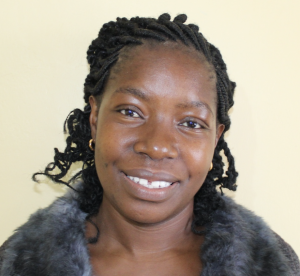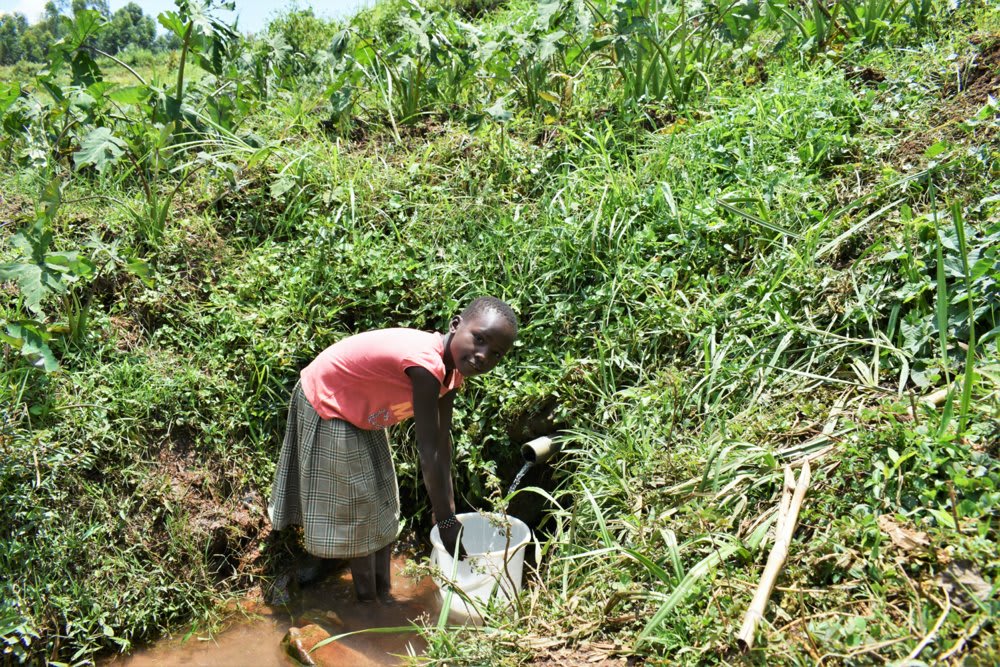April, 2021: Oloo Njinuli Spring Project Complete!
Shihome Community now has access to clean water! We transformed Oloo Njinuli Spring into a flowing source of water, thanks to your donation. Our team protected the spring and trained the community on improved sanitation and hygiene practices, including COVID-19 prevention.
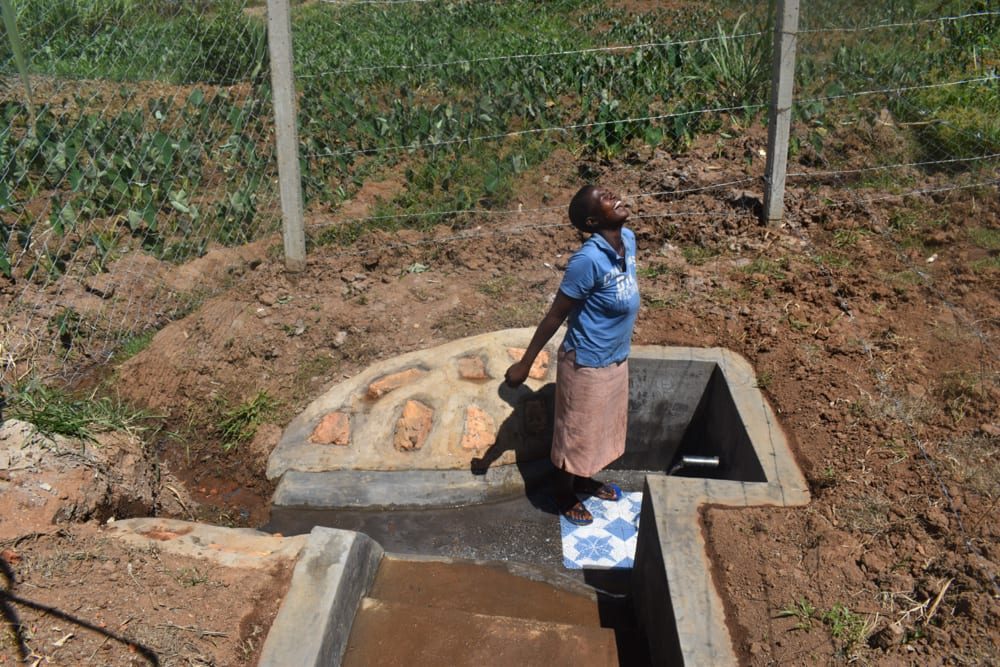
A woman expresses her joy upon the spring's completion.
"Our lives will change for the better because clean and safe water for consumption will be flowing and we will no longer get sick because of the waterborne diseases. I am sure that all time and resources that we wasted on going to the hospital because of waterborne diseases will help me to do other things to help my family," said John Bushuru, the elected Chair of the spring's water user committee.
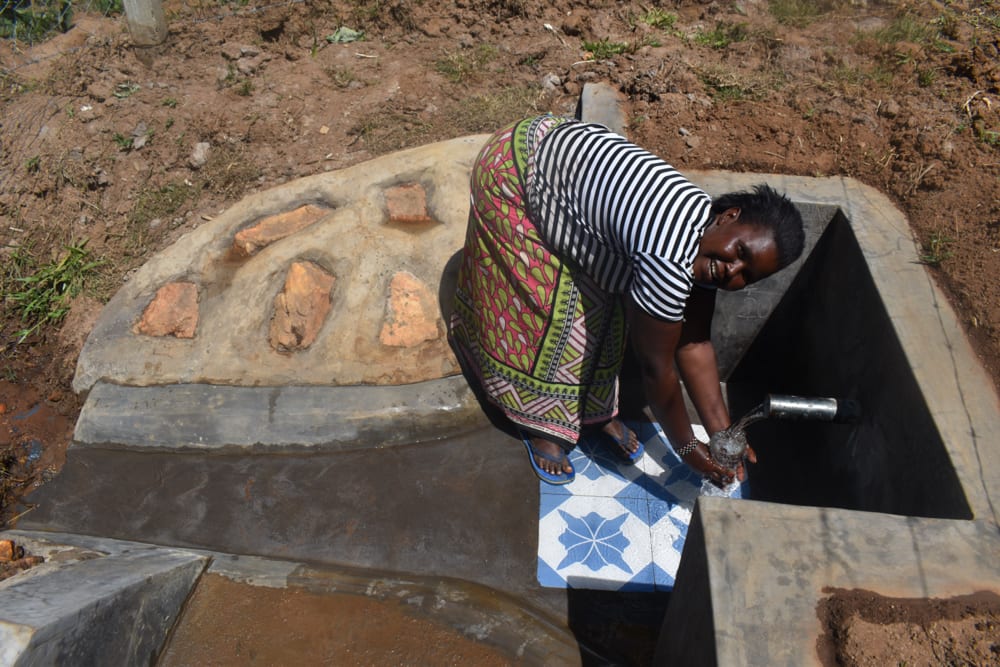
A woman enjoys the flowing water.
Children were just as excited as the adults about the new water point.
"I am so happy because I will be fetching water easily directly from the pipe. I will no longer waste much time at the spring and my family members will no longer worry about me carrying dirty water home again. I will have more time to do my homework because there will be no more queueing at the spring," said young Sarah.

Sarah fetches water at the spring.
Preparing for Spring Protection
Community members worked together to source and carried all locally available construction materials to the spring. These included bricks, sand, stones, and fencing poles. Some people also chiseled away at large stones to break them down into the gravel. Because people have to carry most items by hand, the materials collection process can take anywhere from a few weeks to months.
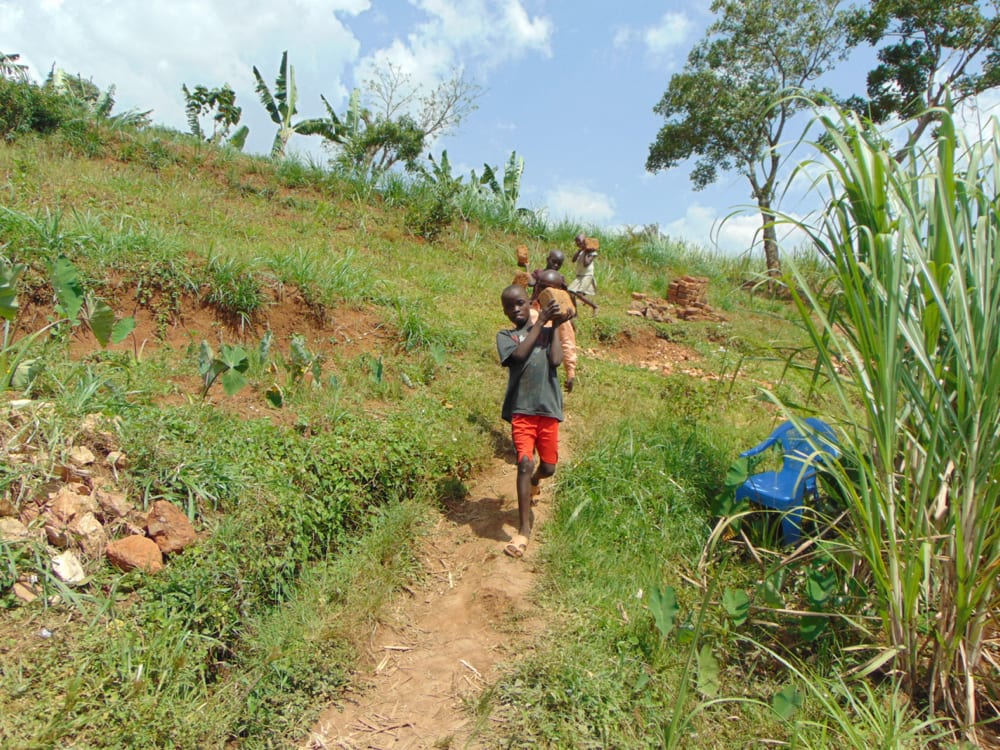
Carrying bricks to the worksite
When everything was prepared, we sent a lorry to the community to deliver the rest of the construction materials, including the cement, plastic tarps, and hardware. Then, our artisan and field officers deployed to the spring to begin work. Individual households provided meals throughout each day to sustain the work team.

Delivering sand to the worksite
From Open Source to Protected Spring: A Step-by-Step Process
At last, it was time to dig in at the spring! Women and men lent their strength to the artisan each day to help with the manual labor. First, we cleared and excavated the spring area. We dug a drainage channel below the spring and several surface runoff diversion channels above and around the spring. These help to divert environmental contaminants carried by the rains away from the spring.

Excavation
To ensure community members could still fetch water throughout the construction process, we also dug temporary diversion channels from the spring’s eye around the construction site. This allowed water to flow without severely disrupting community members’ water needs or the construction work.

Laying the foundation
Excavation created space for setting the spring’s foundation made of thick plastic tarp, wire mesh, concrete, and waterproof cement. After setting the base, we started brickwork to build the headwall, wing walls, and stairs.

Bricklaying
Next, we began one of the most crucial spring protection steps to ensure a fully functional water point: setting the discharge pipe. The discharge pipe has to be low enough in the headwall so that the water level inside never rises above the spring’s eye, yet high enough to leave eighteen to twenty inches between the pipe and the spring floor. This allows room for the average jerrycan (a 20-liter container) to sit beneath the pipe without making contact.

Setting the pipe
If the discharge pipe were placed too high above the spring’s eye, too much backpressure could force the flow to emerge elsewhere. Too low, and community members would not be able to access the water easily. We embedded the pipe using clay (or mortar when the clay is in short supply) and placed it at a slight incline to ensure water flows in the right direction.

Stairs construction
In coordination with brickwork, we pitched medium to large stones on both sides of the spring’s drainage channel. We then cemented and plastered each stone group into place, forming the rub walls. These help to discourage people and animals from trying to stand on that area, which could cause soil erosion and thus a clogged drainage area.

Plastering the stone pitching
With brickwork and stone pitching completed, we turned to cementing and plastering both sides of the headwall and wing walls. These finishing layers reinforce the brickwork and prevent water in the reservoir from seeping through the walls. In turn, enough pressure builds in the reservoir box to push water out through the discharge pipe.

Plastering
As the headwall and wing walls were curing, we cemented and plastered the stairs and installed four tiles beneath the discharge pipe. The tiles protect the concrete from the falling water’s erosive force while beautifying the spring and facilitating easy cleaning of the spring floor.

Setting the tiles
We transitioned to the final stages of construction with the tiles in place - backfilling the reservoir box. First, we cleared the collection box of any debris that may have fallen in since its construction, such as dead leaves or other items. Then we redirected the temporary diversion channels back into the reservoir box, channeling water into this area for the first time. We closed off all of the other exits to start forcing the water through the discharge pipe only.

Backfilling
With much help from the community, we filled up the reservoir area with the clean and large stones they gathered, arranging them in layers like a well-fitting puzzle. We covered the stones with a thick plastic tarp to minimize potential contamination sources from aboveground, followed by a layer of soil. We piled enough soil on top to create a slight mound to compensate for the backfill’s future settlement.

Backfilling
Community members transplanted grass onto the backfilled soil to help prevent erosion. Finally, the collection area was fenced to discourage any person or animal from walking on it since compaction can lead to disturbances in the backfill layers and potentially compromise water quality.

Grass planting
The entire construction process took about two weeks of work and patience to allow the cement and plaster to finish curing. As soon as it was ready, people got the okay from our field officers to fetch water. We officially handed over the spring directly following training to mark the community's ownership of the water point. Happiness, thanksgiving, and appreciation were the order of the day flowing in all directions.

Enjoying the flowing water
Training on Health, Hygiene, COVID-19, and More
Due to the ongoing challenges and restrictions amidst the pandemic, we worked with local leaders and the national Ministry of Health to gain approval for a small group training about health, hygiene, and COVID-19 prevention.
Together with the community, we found their preferred date for training while considering other community calendar events, such as the agricultural season and social events. We requested a representative group of community members to attend training, who will relay the information learned to the rest of their family and friends.

Trainer Sam (right) teaches the ten steps of handwashing.
When the day arrived facilitators Christine Masinde and Samuel Simidi deployed to the site to lead the event. Eleven people attended the training including the local Village Health Volunteers and local political leaders. The attendance was not as expected since at least 15 participants were expected and we asked for gender parity among participants, though of the 11 people only one man was in attendance. The community explained that there was an abrupt parents' meeting in a nearby school where their children attend, so some people who had planned to come to the training ended up having to go to the school.

Handwashing session
We held the training outside in community member John Bushuru's compound. The place was quiet and with few distractions. The trees in the home protected the trainees from the scorching heat of the sun.
Perhaps the most crucial topic of the day was our session on COVID-19 prevention and control. Due to the rampant spread of misinformation about COVID-19, we dedicated time to a question and answer session to help debunk rumors about the virus and provide extra information where needed. We also left behind a rice sack painted with messages of COVID-19 prevention reminders in the local language. We affixed the sign to the spring's fence during training and encouraged community members to use it as a daily reminder to stay cautious both at home and at the spring.

Trainer Christine teaches how to sew a homemade mask.
We covered several other topics, including community participation in the project; leadership and governance; personal and environmental hygiene; water handling and treatment; operation and maintenance of the spring; dental hygiene; the ten steps of handwashing, and how to make and use a tippy tap and leaky tin. We held an election for the newly formed water user committee leaders during the leadership and governance session.

Kitchen gardening session
We also brainstormed income-generating activities that can be used to start a community savings account for any future minor repairs to the spring and a cooperative lending group to enable members to develop small businesses.
"I learned so much that I didn't know during the training. My way of doing things will change because I have more knowledge on general sanitation and hygiene," said training host and farmer John Bushuru. John is also the elected Chair of the spring's water user committee.

Site management training at the spring
"The training has changed my mindset because we have been ignorant and reluctant on following the Ministry of Health guidelines on COVID-19. From today, I will ensure that my family has a handwashing station in my compound and they will always wear masks while going out," said Elizabeth Bushuru.

Holding a glass of clean water from the spring
"Handwashing and wearing of the masks correctly were the most helpful because I learned that washing hands is very important. It helped me to make my own leaky tins in my home. Mask wearing was very important too because we learned the difference between a reusable mask and non-reusable mask and how to wear them correctly to protect ourselves from COVID-19 and other infections," Elizabeth added.
"I will ensure that I have more than one hand washing station in my home for the safety of my family, and we will also have good masks that will protect my family from contracting COVID-19."

When an issue arises concerning the water project, the water user committee is equipped with the necessary skills to rectify the problem and ensure the water point works appropriately. However, if the issue is beyond their capabilities, they can contact our field officers to assist them. Also, we will continue to offer them unmatchable support as a part of our ongoing monitoring and maintenance program.
Thank you for making all of this possible!


 Protected Spring
Protected Spring
 Rehabilitation Project
Rehabilitation Project








